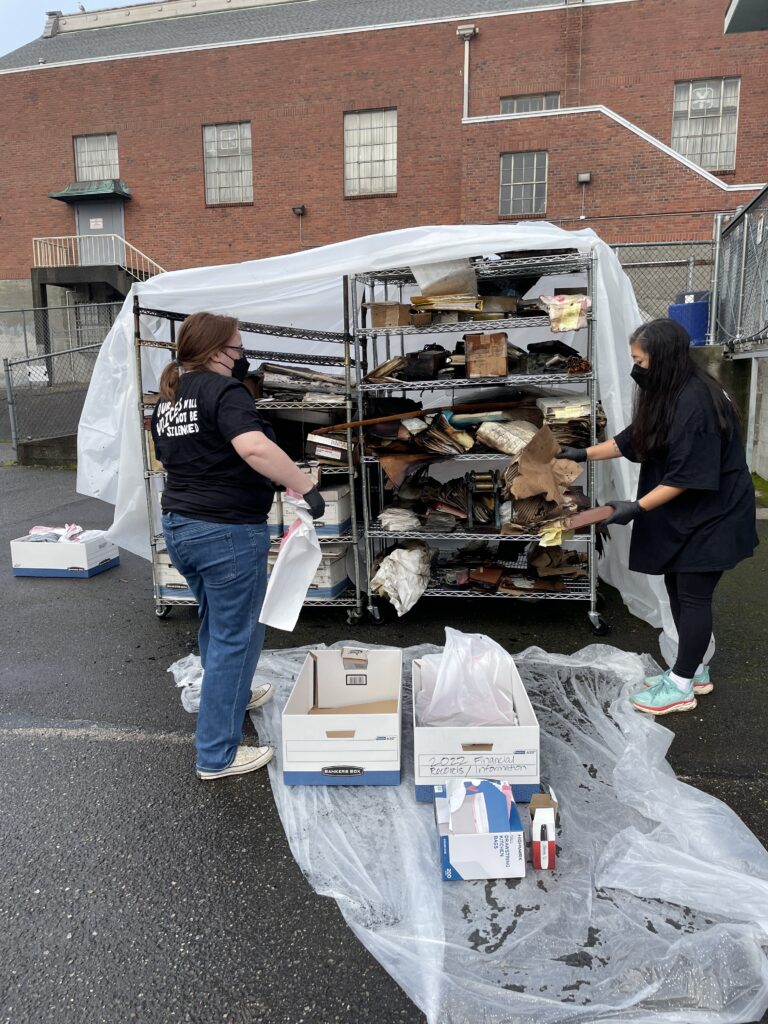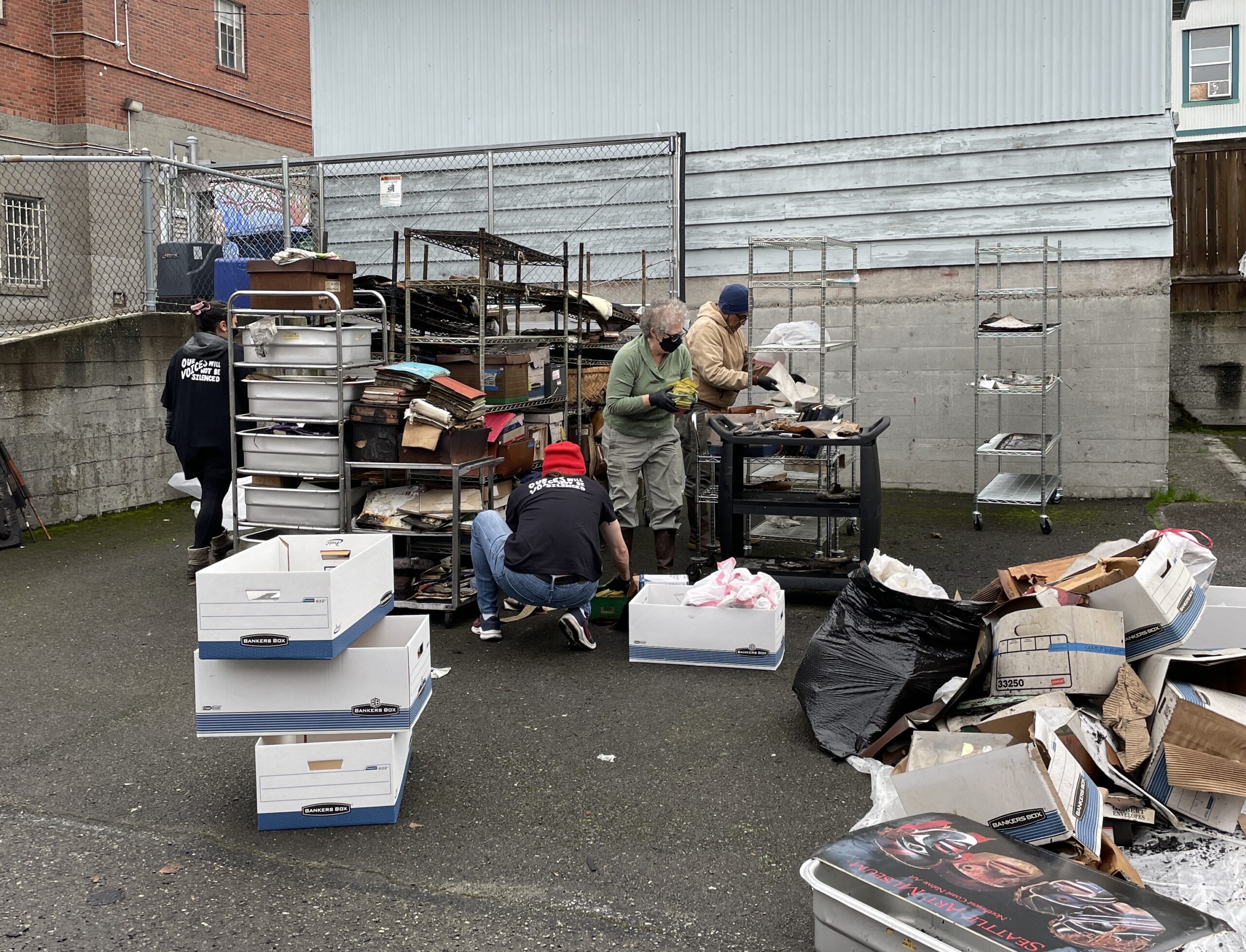September 16, 2024
After helping our neighbors at the Seattle Betsuin salvage archival materials damaged in a fire, Densho Archivist Micah Merryman took steps to level up Densho’s disaster preparedness and protect the invaluable collections stored in our Seattle office. In a conversation with Densho Marketing Manager Kristi Nakata, Micah reflects on what she’s learned about preventing damage to historical photos and documents when disaster strikes, and how to replicate some of these techniques in your own home.
Kristi Nakata: Hi Micah, I hear that you took a class on disaster preparedness. Can you tell me about that?
Micah Merryman: I actually took four different professional development classes over the last few months. I took Introduction to Audio Preservation and Managing Moving Image Collections with the Northeast Document Conservation Center (NEDCC). In both courses we talked about different audio and film formats, and the best way to house and store film and AV collections. They touched on common preservation issues with both of them and how to try and negate that. It’s very similar to issues with paper — AV likes cold and neutral humidity.
Then through Preserve This I took Pest and Mold, and Disaster Planning Basics.
KN: What made you want to take these classes?
MM: I just happened to be the person in the office the day the fire reignited at the Betsuin. I helped the Betsuin and the fire department move items out of the archive and into the Densho parking lot.
I learned a lot of things in these courses that I probably should’ve recommended to the Betsuin that I just didn’t know at the time. Because this happened next door to us it highlighted some gaps in preparedness inside of Densho that we are actively addressing.
KN: Wow, well I’m glad that you have some more practical knowledge and skills! Can you tell me about the pest and mold class?
MM: This course focused on how mold develops in collections, how you prevent that, what to do when it does happen. Mold grows where it is damp and warm, and you can deter it from growing by not providing a good environment.
Once mold does exist it’s hard to get rid of, unless you go through proper remediation. To stop it, you can freeze it so the mold goes dormant. Once you freeze your item for several days to weeks, let it dry in a very well ventilated space. Then preferably with personal safety gear and air filters, you can remove the mold by dusting the dried white powder off and vacuuming it up.
Once an item has been damaged by mold it’s susceptible to mold again because it will always have a little bit of mold. The best way to prevent the mold from reactivating is to make sure you isolate that from the rest of your materials and maintain a dry neutral temperature so it doesn’t regrow. But sometimes, the best solution is to digitize the item and throw it away.
In the portion of the class that focused on pests, we learned how to identify common pests in paper collections, how they damage materials, and what you can do to prevent that from happening. The best solution is to store things in moderate temperatures and low humidity. Before you introduce a new item into your collection, freeze it or isolate them for a few weeks to see if anything pops up.
KN: What about disaster planning?
MM: Water damage is the most common type of damage to historical materials which can then result in mold. You can get water damage from a burst pipe, a hurricane, a flood, or even a fire. When materials get soaked with water, the best thing to do is freeze them immediately to prevent mold growth. Paper can be frozen, but photographs should be air dried.
The best way to dry to prevent mold growth is to let the wet item dry in the sun. If you have a book that gets wet, you can interleaf it with paper towels every few pages to absorb the moisture from the center. Then, you can sit the book upright to circulate air.
KN: Did you learn about other types of damage other than water?
MM: If your materials are exposed to a fire they can get covered in ash and soot and take on carcinogens. You have to let it air out.
We also talked about wind damage, how to prepare your building from a tornado. That’s not very relevant to us here in the Northwest, but it’s best to put your materials in a finished basement if you live in an area that experiences tornados.

Finally, we learned about people damage — risk to historical institutions and archives from people or cybersecurity threats. If you preserve your materials digitally, you can save your materials in multiple places — on a CD in your home, on a hard drive, give to a family member in a different area than you, or in a cloud service.
KN: How do you think you’ll implement what you learned at Densho?
MM: After the Betsuin fire, it lit a fire under all of us at Densho to make a plan for our own building. We are thinking about all the different ways that the collections and staff in our building could be put at risk. It was nice to be in a class, even though it was online, to be able to talk to other people about fire and water disasters and share my experience responding to an actual fire and reflect on my instincts.
KN: What can the average person do at home to avoid this?
MM: The ideal storage temperature for paper is 50-60 degrees and a relative humidity of 30-50%. If you’re storing your items in a finished basement, keep them at least 4 inches off of the floor. Most flooding is less than 4 inches so that will ensure protection. You can also store them in plastic bins with lids.
KN: Well thank you for sharing this important info. It sounds like Densho’s archives are in safe hands!
–
Thank you to 4Culture’s Heritage Professional Development Stipend.
Learn more about disaster preparedness from:
[Header: Densho staff sort through items salvaged from the Seattle Betsuin’s archives after the fire.]
